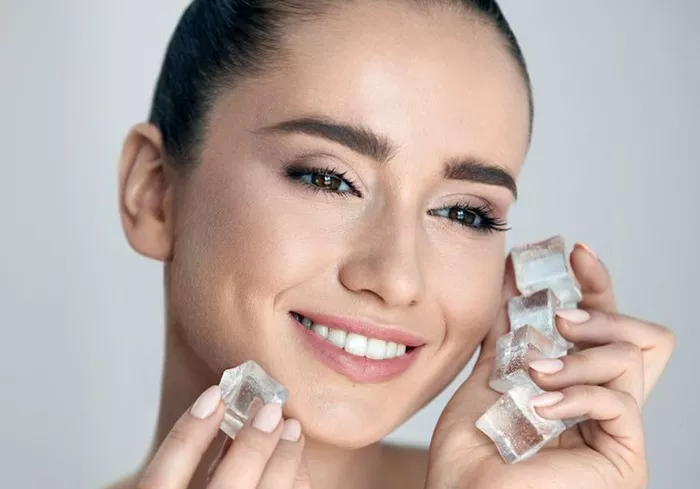Icing your face has become a popular trend in the world of skincare. This cold therapy, also known as facial icing, involves applying ice or cold tools to the skin to improve circulation, reduce inflammation, and tighten pores. But with all the benefits facial icing offers, the timing of when to ice your face in your skincare routine can make all the difference. In this article, we will explore the ideal times to incorporate facial icing into your skincare regimen, as well as the best practices to follow.
Facial Icing
Facial icing is the practice of applying cold temperatures to the skin using ice cubes, chilled tools, or ice packs. The cold constricts the blood vessels in the skin, leading to a range of benefits that can enhance your overall complexion. It can also help calm inflamed skin, reduce puffiness, and give your face a refreshed, rejuvenated look.
Many people use facial icing as part of their skincare routine to promote a healthy glow, reduce acne, and even improve the effectiveness of other skincare products. Facial icing can be done in different ways, but it’s essential to know when and how to do it properly for maximum results.
The Benefits Of Icing Your Face
Before diving into the best times to ice your face, it’s crucial to understand why this practice is beneficial in the first place. Facial icing offers a wide range of skincare benefits that cater to various skin concerns.
Reduces Puffiness
One of the most common reasons people turn to facial icing is to reduce puffiness, especially around the eyes. Cold temperatures help constrict the blood vessels, which reduces swelling and makes your face appear more toned.
Improves Circulation
Applying cold to your skin stimulates circulation by causing blood to rush to the surface. This can help improve your skin tone and give you a natural glow, making your complexion appear more radiant and healthy.
Tightens Pores
Cold temperatures can tighten your skin and reduce the appearance of enlarged pores. Icing your face helps to create a smooth, even texture by temporarily shrinking pores, which minimizes the chances of dirt and oil buildup.
Calms Inflammation
If you have inflamed skin due to acne, sunburn, or other irritations, icing your face can help calm the inflammation. The cold reduces redness and soothes sensitive skin, providing relief from discomfort.
Enhances Product Absorption
Facial icing can also improve the absorption of your skincare products. By applying cold temperatures after using serums or moisturizers, you can help your skin absorb the ingredients more effectively, maximizing their benefits.
Soothes Skin Post-Treatment
If you’ve recently undergone a skincare treatment, such as microneedling, chemical peels, or laser therapy, icing your face can soothe and calm your skin. The cold helps reduce redness and irritation, speeding up the recovery process.
When To Ice Your Face In Your Skincare Routine
Now that we understand the benefits of facial icing, let’s explore the optimal times to incorporate this practice into your skincare routine. The timing of when you ice your face is crucial to achieving the best results.
In The Morning To Wake Up Your Skin
One of the best times to ice your face is in the morning as part of your wake-up routine. When you wake up, your skin may appear puffy or tired due to fluid retention or a lack of circulation. Icing your face first thing in the morning helps to refresh and energize your complexion.
Start your day by washing your face with a gentle cleanser, and then proceed to apply ice or a cold tool to your skin. Focus on areas prone to puffiness, such as under the eyes, the cheeks, and the jawline. This morning ritual will leave your skin feeling tight and awake, giving you a refreshed appearance for the day ahead.
Before Applying Makeup For A Smoother Base
If you want your makeup to last longer and go on smoothly, facial icing can be a game-changer. Applying ice to your face before your makeup routine can tighten your skin, reduce oiliness, and create a smooth, even surface for foundation and concealer. This makes it easier for your makeup to glide on without caking or settling into fine lines.
For best results, cleanse your face and apply a moisturizer or primer, then follow up with gentle facial icing. This will minimize the appearance of pores and control excess oil, allowing your makeup to look flawless and last throughout the day.
After A Workout To Cool Down And Decrease Redness
After an intense workout, your skin might appear flushed due to increased blood flow. Applying ice or a cold compress to your face can help cool down your skin, reduce redness, and restore balance. This is particularly beneficial if you have sensitive skin that reacts to heat and exercise.
After exercising, cleanse your skin to remove any sweat or impurities, and then apply ice for a few minutes. This not only calms your skin but also prevents post-workout breakouts by reducing inflammation and tightening pores.
At Night Before Applying Your Night Cream
Another excellent time to ice your face is in the evening before applying your night cream. During the night, your skin undergoes a repair process, and using ice before applying nourishing products can enhance absorption.
After cleansing your face, use an ice cube or cold tool to massage your skin gently. This will calm your skin after a long day, reduce any puffiness from stress, and prepare your skin to fully absorb the benefits of your night cream or serum.
See Also: What Is Minimalist Skincare?
When You Have Breakouts To Calm Inflammation
If you’re experiencing a breakout or inflammation due to acne, icing your face can provide relief and minimize redness. Cold therapy helps reduce swelling and irritation, making your skin feel more comfortable and appear less inflamed.
Incorporate icing into your skincare routine when you notice active breakouts forming. Apply ice directly to the affected areas for a few minutes to calm the skin and prevent the breakout from getting worse.
After Exfoliation To Soothe The Skin
Exfoliation is an essential step in any skincare routine, but it can sometimes leave the skin feeling sensitive or irritated. Facial icing after exfoliation can soothe your skin, reduce redness, and provide instant relief. It helps to close the pores that have been opened during exfoliation, locking in moisture and nutrients from your skincare products.
Use ice or a cold tool after exfoliating your skin to ensure a calm and smooth complexion. This is particularly useful if you have sensitive or reactive skin that tends to become red or irritated after exfoliating.
How To Ice Your Face Safely
While facial icing can be highly beneficial, it’s essential to follow safe practices to avoid damaging your skin. Improper use of ice or cold temperatures can lead to frostbite, irritation, or broken capillaries. Here’s how to ice your face safely:
Wrap The Ice In A Cloth
Never apply ice directly to your skin, as this can cause frostbite or cold burns. Instead, wrap the ice cubes in a clean cloth or towel before applying them to your face. This barrier prevents direct contact with the skin while still providing the cooling effects.
Limit The Duration
Facial icing should be done in short intervals to avoid overexposure to the cold. Aim to ice your face for about 1-2 minutes at a time, focusing on different areas of your face. Prolonged exposure can lead to irritation, so keep the sessions brief but effective.
Avoid Sensitive Areas
Be mindful of sensitive areas on your face, such as around the eyes or broken skin. If you have an open wound or severe acne, avoid applying ice directly to those spots. Stick to areas that can tolerate the cold, such as the forehead, cheeks, and jawline.
Use Gentle Pressure
When applying ice or a cold tool to your face, use gentle pressure. Avoid pressing too hard or rubbing the ice against your skin, as this can lead to irritation or broken capillaries. Instead, glide the ice smoothly over your skin in a circular motion.
Follow Up With Moisturizer
After icing your face, it’s essential to hydrate your skin. The cold can sometimes cause temporary dryness, so be sure to follow up with a moisturizer or serum to replenish moisture. This helps lock in hydration and prevent your skin from becoming overly dry or tight.
Conclusion
Incorporating facial icing into your skincare routine can offer numerous benefits, from reducing puffiness and tightening pores to calming inflammation and enhancing product absorption. The timing of when to ice your face plays a crucial role in achieving optimal results, whether it’in the morning to wake up your skin, before makeup for a smoother application, or at night to enhance your skincare products.
Related Topics

































